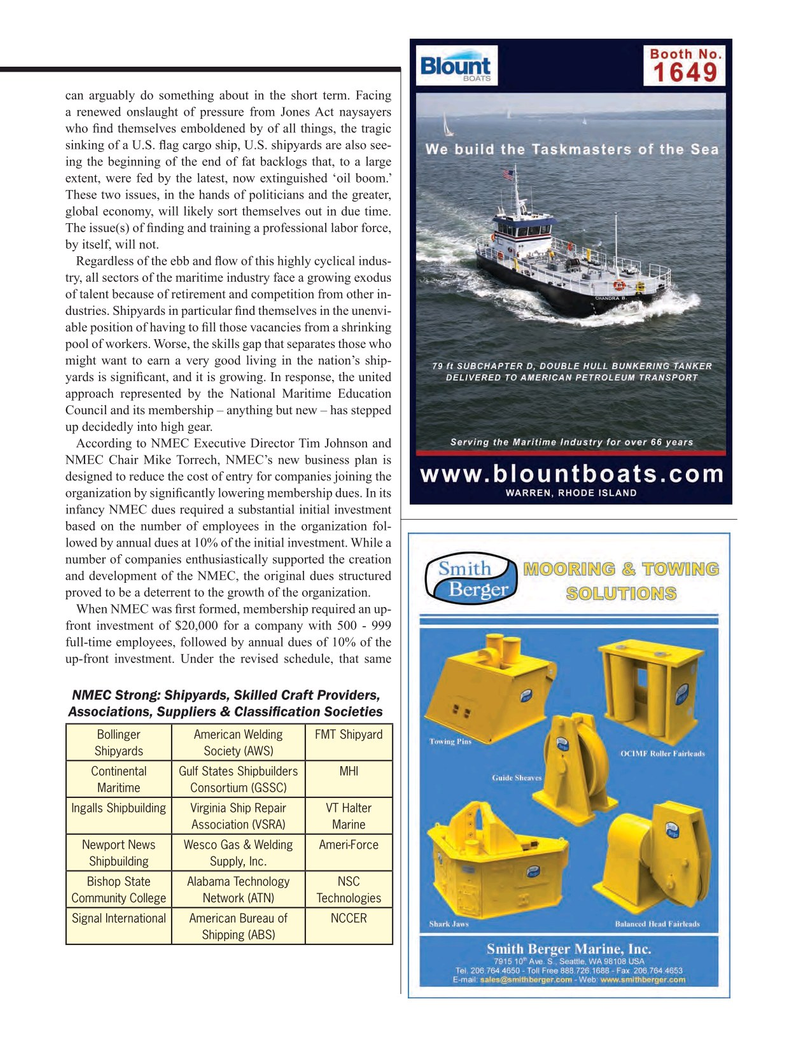
Page 25: of Maritime Logistics Professional Magazine (Q4 2015)
Read this page in Pdf, Flash or Html5 edition of Q4 2015 Maritime Logistics Professional Magazine
can arguably do something about in the short term. Facing a renewed onslaught of pressure from Jones Act naysayers who ? nd themselves emboldened by of all things, the tragic sinking of a U.S. ? ag cargo ship, U.S. shipyards are also see- ing the beginning of the end of fat backlogs that, to a large extent, were fed by the latest, now extinguished ‘oil boom.’
These two issues, in the hands of politicians and the greater, global economy, will likely sort themselves out in due time.
The issue(s) of ? nding and training a professional labor force, by itself, will not.
Regardless of the ebb and ? ow of this highly cyclical indus- try, all sectors of the maritime industry face a growing exodus of talent because of retirement and competition from other in- dustries. Shipyards in particular ? nd themselves in the unenvi- able position of having to ? ll those vacancies from a shrinking pool of workers. Worse, the skills gap that separates those who might want to earn a very good living in the nation’s ship- yards is signi? cant, and it is growing. In response, the united approach represented by the National Maritime Education
Council and its membership – anything but new – has stepped up decidedly into high gear.
According to NMEC Executive Director Tim Johnson and
NMEC Chair Mike Torrech, NMEC’s new business plan is designed to reduce the cost of entry for companies joining the organization by signi? cantly lowering membership dues. In its infancy NMEC dues required a substantial initial investment based on the number of employees in the organization fol- lowed by annual dues at 10% of the initial investment. While a number of companies enthusiastically supported the creation and development of the NMEC, the original dues structured proved to be a deterrent to the growth of the organization.
When NMEC was ? rst formed, membership required an up- front investment of $20,000 for a company with 500 - 999 full-time employees, followed by annual dues of 10% of the up-front investment. Under the revised schedule, that same NMEC Strong: Shipyards, Skilled Craft Providers,
Associations, Suppliers & Classi? cation Societies
Bollinger American Welding FMT Shipyard
Shipyards Society (AWS)
Continental Gulf States Shipbuilders MHI
Maritime Consortium (GSSC)
Ingalls ShipbuildingVirginia Ship Repair VT Halter
Association (VSRA) Marine
Newport News Wesco Gas & Welding Ameri-Force
Shipbuilding Supply, Inc.
Bishop State Alabama Technology NSC
Community College Network (ATN) Technologies
Signal InternationalAmerican Bureau of NCCER
Shipping (ABS) 18-33 Q4 MP2015.indd 25 11/18/2015 10:08:55 AM

 24
24

 26
26
